Garage Door Weather Seal Overview
There are many different types of garage doors; the most common is steel, then wood, aluminum, fiberglass, glass, insulated and non insulated.
Regardless of the type of door, that is the type of material the door is made of, be it an insulated or non insulated door, proper weather stripping of the door is a must.
Garage Doors that are properly sealed will:
Keep water, snow, leaves, insects, rodents and debris from entering the garage. You will also recognize a substantial financial savings if the area is heated or cooled. Additionally, preventing moisture from getting under the door, particularly at the corners, will reduce rusting of the door cables, bottom bracket and roller and the door track. A properly sealed garage door will reduce maintenance costs.
There are three primary areas of a garage door that need proper weather seal.
The sides of the door, the top and the bottom of the door.
Side and top seals are sometimes referred to as : Garage Door Stop Molding, Garage Door Weather Seal Molding, garage door trim molding, Door Weatherstripping, , Weather Stripping, Garage Door Seal, Garage Door Trim and plain old door stop.
Side and top seals are typically nailed to the door jamb and have a vinyl flap molded to the PVC portion that folds over onto the garage door sealing off the gap between the door and the door jamb. The part of the weather seal that is nailed to the jamb is made from PVC and is available in a wide variety of colors. Matching colored nails are also available, PVC is a durable product that will not fade and is easy to work with. This is paintable but advisable to match the color of molding to your needs. Typically the PVC portion is imprinted with a wood grain finish to further compliment the overall finish and look of the garage door.
This door stop is square cut, not mitered. The top is installed first, then the sides measured, cut and nailed in place.
See our tutorial on installing side and top seals for detailed installation instructions.
Garage Door Bottom Seal
Bottom seal for a garage door can be referred to as: Weather Seal, Garage Door Bottom Seal, Door Weatherstipping, Rubber seal, garage door draught excluder, door bottom seal and so on.
Here we need to take a close look at the existing weather seal in order to determine the correct replacement seal.
As stated, most residential garage doors are steel, there are other types of doors but steel doors are by far the most common.
Steel, aluminum, fiberglass and other types of garage doors have a channel on the bottom of the door that the weather seal slides into. This is called the retainer. The retainer is attached to the bottom of the door. Some retainers are actually a part of the door but most are a separate entity from the door itself. Retainers can be made of Steel, Aluminum or PVC.
The most common garage door bottom seal is U shaped with T ends that slide into the retainer. The T width is not all the same, ¼” is by far the most common but 5/16” is also used by some garage door manufactures. We have a wide selection or ¼” T style weather seal and 5/16” T style in several sizes. There are several other styles of weather seal, such as bead style and bulb style. Wayne Dalton uses a type that is a cross between a T and a bead style. Overhead Door brand garage doors use several types of seal that are exclusive to their doors.
You may find other types or styles of bottom seal on your particular application. If the current type or style of weather seal on the door is not readily available the solution is to replace the retainer (see above) with the common T style type. There is a wide selection of weather seals available for the T style U shaped seal. Common vinyl, rubber, PVC, Rodent Proof, Super Seal with a tube bonded to the inside of the U. There are also various sizes of T style available 3”, 4”, 6” (laid flat) to accommodate any situation.
We offer a complete kit that includes the garage door bottom retainer and the weather seal. When considering a kit, you will need to measure the thickness of your door and the width. Common garage door thickness is 1-3/8” & 2”, with 8, 9, 10, 12, 14, 16 & 18’ being the typical width. The weather seal kit is a simple solution and is very easy to install. You can also purchase the retainer and weather seal separately to match your situation.
Wooden garage doors have the weather seal nailed directly to the bottom of the door. There are two standard types of bottom seal availed for wood garage doors. One is a soft sponge type that will conform to slight irregularities in the floor. There is also a dense rubber seal that although it is a bit more durable does not conform to irregularities as well as the soft sponge type. If you have a smooth and level door the dense rubber may be the better option, sponge type if the floor is a bit un even.
Another option for wood garage doors is the retainer and weather seal system explained above. There are flat retainers, L shaped and a cap style that is similar to the adjustable bottom cap on a screen door. Here again you can buy a kit or mix and match the retainer and weather seal to suite your needs.
Browse our store under weather seal to see all options or choose one of the more specific categories under weather seal to go directly to any known product. You can also use the search box.
See our other tutorials and videos on different types and installation of garage door bottom seals.
Below are some examples of weather seal discussed in this post.


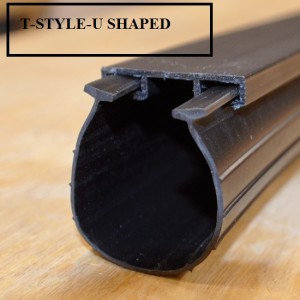
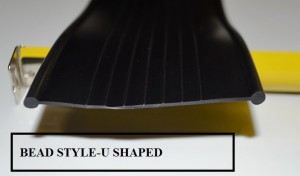
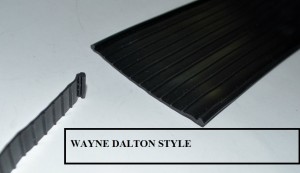
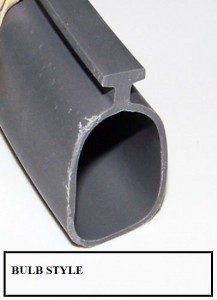
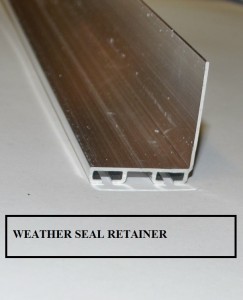



Comments are closed.